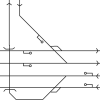Having experienced the southern commuter belt of both the MML and the ECML, I am massively in favour of quadrupling by direction. However it seems that places me in the minority. The reason I think this is simple: what is fast/slow in one place might not be in another. For example, on the MML, all Thameslink trains have to use the slow tracks, no matter where they are stopping or passing. This means that the capacity for slow trains is greatly reduced while the fast tracks sit fairly empty (EMR only have about 6 trains per hour in each direction out of St. Pancras). This also means that a broken rail (or similar issue) is a nightmare as crossing between the fast and slow tracks is much more inconvenient (which is why the fast Thameslink trains don't do it).
In contrast, on the ECML, fast Thameslink trains can hop between the fast and slow lines with ease, allowing them to switch based on their stopping patterns. For example, the Cambridge-Brighton service joins the ECML on the slow tracks, then after the Digswell viaduct when it expands to four tracks again it stays on the fast lines. Then, at Finsbury Park it crosses over to the semi-fast platform, which then takes it on the slow track towards the canal tunnels. Equally, when there was a broken rail on the up fast a couple of months ago, it was fairly easy for fast trains to cross over to the down fast at the crossing before, and back at the crossing after. Had that been on the southern MML, all hell would break loose.
The other final advantage is based on the fact that realistically, all four-track lines go down to two at some point, whether that's because the line was never quadrupled that far, or because of infrastructural reasons. With quadrupling by direction, this is much more convenient than trying to do this with distance quadrupling, because trains going from one set of tracks to the other don't have to cross another line in the process.
Equally, converging and diverging lines are easier as with directional quadrupling, you can use the following layout:

While on distance quadrupling, you have to do this:

(note while the lack of a flyover/under here makes it cheaper, that's only because building this junction graded is effectively impossible)
If you disagree with my assertions, or agree but would like to play devil's advocate, please feel free to do so . I am happy to be wrong as long as I can see why I'm wrong
. I am happy to be wrong as long as I can see why I'm wrong 
In contrast, on the ECML, fast Thameslink trains can hop between the fast and slow lines with ease, allowing them to switch based on their stopping patterns. For example, the Cambridge-Brighton service joins the ECML on the slow tracks, then after the Digswell viaduct when it expands to four tracks again it stays on the fast lines. Then, at Finsbury Park it crosses over to the semi-fast platform, which then takes it on the slow track towards the canal tunnels. Equally, when there was a broken rail on the up fast a couple of months ago, it was fairly easy for fast trains to cross over to the down fast at the crossing before, and back at the crossing after. Had that been on the southern MML, all hell would break loose.
The other final advantage is based on the fact that realistically, all four-track lines go down to two at some point, whether that's because the line was never quadrupled that far, or because of infrastructural reasons. With quadrupling by direction, this is much more convenient than trying to do this with distance quadrupling, because trains going from one set of tracks to the other don't have to cross another line in the process.
Equally, converging and diverging lines are easier as with directional quadrupling, you can use the following layout:

While on distance quadrupling, you have to do this:
(note while the lack of a flyover/under here makes it cheaper, that's only because building this junction graded is effectively impossible)
If you disagree with my assertions, or agree but would like to play devil's advocate, please feel free to do so
 . I am happy to be wrong as long as I can see why I'm wrong
. I am happy to be wrong as long as I can see why I'm wrong 

